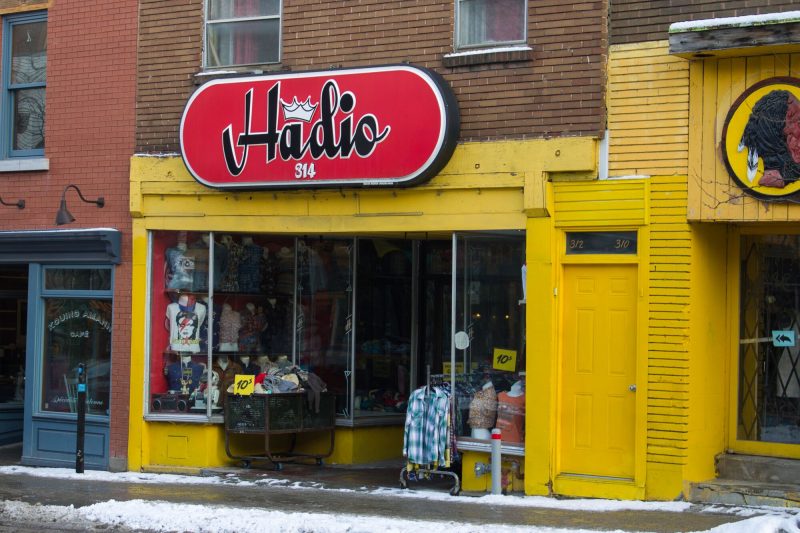Just over a year ago, I decided to stop buying fast fashion.
This decision stemmed from an unnerving experience opening a parcel from Urban Outfitters, wherein I found a hair — a human hair to be precise — on my (made in Bangladesh) denim skirt. The idea that this hair belonged to a factory worker, most probably underage, most definitely underpaid, was enough to make me pack up the skirt and send it back.
Since then, I have shopped exclusively from ethical and sustainable local, independent designers and transparent brands, as well as vintage and thrift shops. As a fashion school graduate and someone who works in the fashion industry, this proved to be a challenge in the beginning.
Where was I supposed to find something new, in good condition, hip, not-too-trendy, and that conveyed my personal style?
After a year’s worth of scouting my options in and around the city, I’ve compiled a repertoire of my go-to thrift shops in Montreal. Whether your budget is high or low, or if you are looking for something trendy, there is definitely something for everyone.
For a classic thrift experience, Fripe-Prix Renaissance Plateau (Mont-Royal Ave.) offers a great selection of items at a super reasonable price. There are racks on racks of clothing and accessories, as well as an extensive offering of books and vinyls, all in great condition.
L’Armée du Salut (Notre-Dame St. in Griffintown) has — in my opinion — the best selection of pants and denim. With over seven racks of bottoms alone, you can find anything from a pair of vintage Levi’s to a pair of corduroys, at prices typically ranging from $3 to $12.
If you have a slightly higher budget but still want the authentic “thrift” experience, there are tons of shops for you. The infamous Eva B on St-Laurent Blvd. remains more expensive than your average thrift store, with prices averaging $20. However, their exciting mish-mash of retro fabrics, prints, and patterns is sure to brighten your wardrobe.
For staple pieces, such as flannels and denim shirts, Hadio (Mont-Royal Ave.) is the place to go. Their prices are more expensive than your average thrift store, but with shirts lining every inch of the wall, you are sure to find a quality vintage item in brand new condition.
For some funky finds, The Little Shop in Parc-Ex is a great spot to hit up. With a much more eclectic feel, you can find a variety of vintage hats, fur coats, and party dresses. If you’re into more of a street style look, L N F Shop on Parc Ave. offers a mix of old and new, from vintage Nike to some more recent pieces from brands like Atelier New Regime.
Many thrift shops offer more of a boutique-style experience in Montreal. The only downside is that with a more curated selection comes a more elevated pricetag, and thus, not necessarily a classic thrift experience.
However, for those trying to stop supporting fast-fashion, shops such as Annex Vintage on St-Viateur St. offers curated pieces that often hit the racks in collections, and provide a variety of trendy clothing in brand new condition, with a price that remains lower than that of fast-fashion giants such as Zara and H&M. From week to week, you can find the store filled with anything from denim or velvet items, to retro winter puffer jackets.
Similarly, Ex-Voto on St-Laurent Blvd. in Little Italy offers a smaller, well-curated variety of clothing. They also have a wide selection of locally made goods, jewelry, and accessories, making it the perfect place to shop for gifts.
If you’re looking for unique pieces, Citizen Vintage is the place for you. Their two locations, in the Plateau and in Mile End, offer vintage items which have been altered and repaired, having them looking brand new. In addition, they have an in-house collection, Studio Citizen, consisting of clothing that has been made by hand in Montreal, from fabric scraps and deadstock fabric, ensuring that nothing goes to waste.
With three locations spread out across Mile End and Little Italy, Empire Exchange offers a great selection. I’ve found my fair share of designer items at the various Empire Exchange locations — a Burberry polo and Saint Laurent denim shorts, among others — making it a great place to keep an eye on and peruse the racks every now and then. Who knows what you’ll find?
Whether you’re contributing to a circular cycle in an effort to be more sustainable, making a conscious effort to not support companies who exploit their workers, or trying to stick within a budget, thrifting is a feel-good pastime that is sure to bring out your personality and satisfy your need for shopping.
Photos by Brittany Romeo-Clarke
